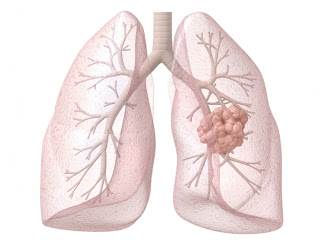The Lungs and Its Cancer
Your lungs are 2 wipe like organs discovered in your
midsection. Your right lung is separated into 3 segments, called flaps. Your
left lung has 2 projections. The left lung is more modest on the grounds that
the heart consumes up additional space on that side of the form. When you take
in, air enters through your mouth or nose and goes into your lungs through the
trachea (windpipe). The trachea separates into tubes called the bronchi
(solitary, bronchus), which enter the lungs and separate into more modest limbs
called bronchioles. At the finish of the bronchioles are small air sacs
regarded as alveoli.Numerous small veins gone through the alveoli. They osmose
oxygen from the breathed air into your bloodstream and pass carbon dioxide from
the form into the alveoli. This is casted out from the form when you sigh.
Taking in oxygen and disposing of carbon dioxide are your lungs' primary
capacities.A dainty coating layer called the pleura encompasses the lungs. The
pleura ensures your lungs also helps them slide over and over again against the
midsection divider as they develop and contract throughout relaxing. Underneath
the lungs, a dainty, vault formed muscle called the stomach differentiates the
midsection from the stomach area. When you inhale, the stomach climbs and down,
constraining air in also out of the lungs.
Begin and spread of lung malignancy
Lung malignancies can begin in the cells covering the
bronchi and parts of the lung, for example the bronchioles or alveoli.
Lung malignancies are thought to begin as zones of
precancerous updates in the lung. The principal updates in the genes (DNA)
inside the lung cells might make the units develop quicker. These cells might
look a spot anomalous seen under a magnifying lens, however right now they do
not shape a mass or tumor. They can't be seen on a x-beam and they don't cause
side effects. Over the long run, the anomalous might obtain other gene updates,
which make them advancement to correct growth. As a growth advances, the
disease cells might make chemicals that cause fresh recruits vessels to
structure close-by. These veins support the malignancy units, which can press
on to develop and structure a tumor expansive enough to be seen on imaging
tests for example x-flashes. Sometime or another, units from the growth might
split far from the definitive tumor and spread (metastasize) to different parts
of the form. Lung malignancy is frequently a life-undermining malady on the
grounds that it has a tendency to spread thusly even before it might be
discovered on an imaging test for example a midsection x-beam. The lymph
(lymphatic) framework The lymph framework is one of the courses in which lung
malignancies can spread. This framework has numerous parts:
1. Lymph hubs are little, bean-molded accumulations of invulnerable
framework (cells that battle contaminations) that are associated by
lymphatic vessels.
2. lymphatic vessels are like little veins, with the exception of that
they convey a reasonable liquid called lymph (rather than blood) far
from the lungs.
3. lymph holds overabundance liquid and squander items from form tissues,
and in addition invulnerable framework cells. Lung malignancy cells can
enter lymphatic vessels and start to develop in lymph hubs around the bronchi
and in the mediastinum (the zone between the 2 lungs).
When lung malignancy
cells have arrived at the lymph hubs, they are more inclined to have spread to
different organs of the form simultaneously. The stage (degree) of the cancer and choices about medicine are situated in part on whether the
malignancy has spread to the adjacent lymph hubs in the mediastinum. These
points are examined later in the segment "How is non-little unit lung
malignancy arranged?" Sorts of major lung malignancy are
1.
Small cell lung
Cancer (SCLC)
2.
Non-small cell lung cancer (NSCLC)

No comments:
Post a Comment